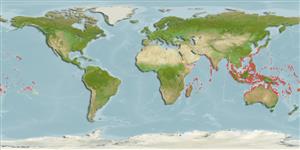Common names from other countries
Classification / Names / Names
Nomi Comuni | Sinonimi | Catalog of Fishes (gen., sp.) | ITIS | CoL | WoRMS
Environment: milieu / climate zone / depth range / distribution range
Ecologia
Associati a barriera corallina; distribuzione batimetrica 0 - 6 m (Ref. 96667). Tropical; 36°N - 33°S, 29°E - 134°W
Indo-Pacific: north from Japan, China, Taiwan to southeast Asia, west to Australia, Christmas Island, Cocos (Keeling) Islands to India, Oman and east Africa.
Length at first maturity / Size / Peso / Age
Maturity: Lm ? range ? - ? cm Max length : 8.0 cm CW maschio/sesso non determinato; (Ref. 343)
Carapace is oval in shape which is covered with tubercles. The frontal margin has six or more spines. Pair of pincers are unequal in size and are covered with very tiny granules (Ref. 128968).
Adults are found in rock cracks in shallow waters. They display aggressive and nocturnal behaviour (Ref. 128968). Collected for food. Occasionally mildly poisonous in some parts of its range. Mildly poisonous (Ref. 79155). Inhabits rocky shore or reefs. Benthic. Subtropical and tropical climates (Ref. 343). Intertidal (Ref. 106854). Also occurs on algal mat (Ref. 106227). Found within crevices in rocks or coral reefs (Ref. 79155). Observed on mangrove trees (Ref. 74547). Has large master claws with molariform teeth used to crush shells of snails and hermit crabs (Ref. 107019). Observed to open large Turbo sp. Shells in order to extract the terrestrial hermit crab Coenobita perlatus (Ref. 76500).
Life cycle and mating behavior
Maturità | Riproduzione | Deposizione | Uova | Fecundity | Larve
Members of the order Decapoda are mostly gonochoric. Mating behavior: Precopulatory courtship ritual is common (through olfactory and tactile cues); usually indirect sperm transfer.
Ng, P.K.L. 1998. (Ref. 343)
IUCN Red List Status (Ref. 130435)
CITES status (Ref. 108899)
Not Evaluated
Not Evaluated
Threat to humans
Poisonous to eat (Ref. 128968)
Human uses
Pesca: commerciale
| FishSource | Sea Around Us
Strumenti
Fonti Internet
Estimates based on models
Preferred temperature
(Ref.
115969): 24.8 - 29.3, mean 28.4 (based on 3372 cells).
Resilienza
Alto, tempo minimo di raddoppiamento della popolazione meno di 15 mesi (K=0.68).
Vulnerability
Low vulnerability (10 of 100).
Price category
Unknown.
